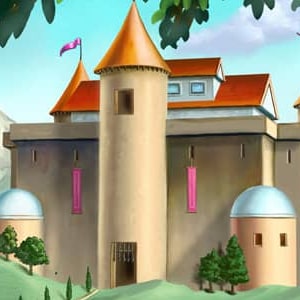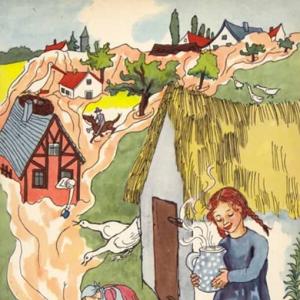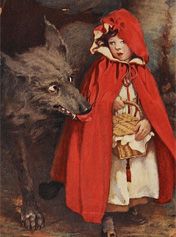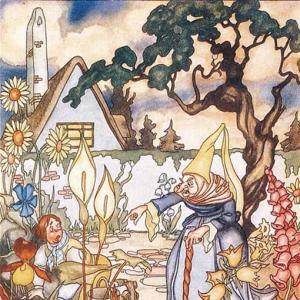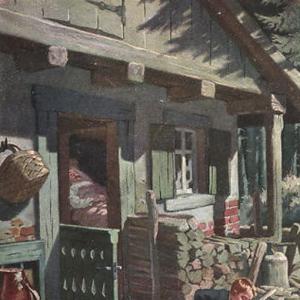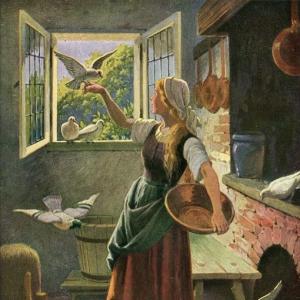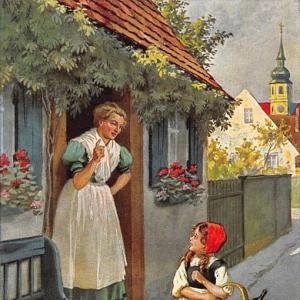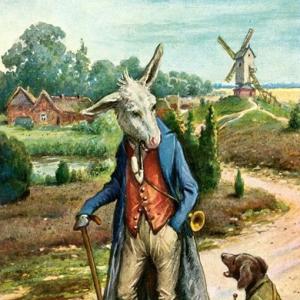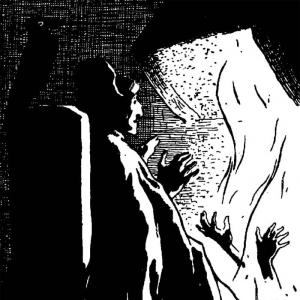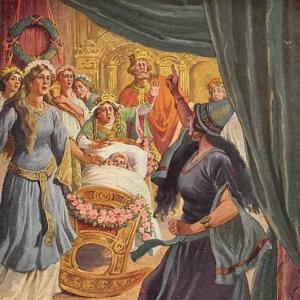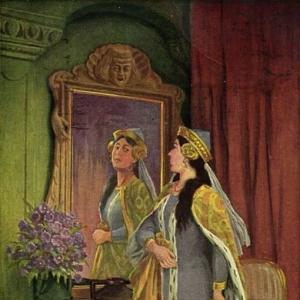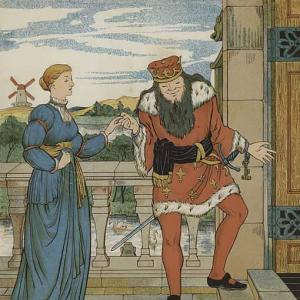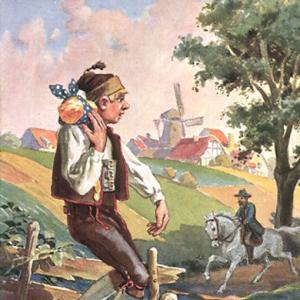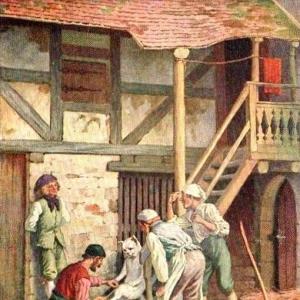Reading time for children: 8 min
A sparrow had four young ones in a swallow’s nest. When they were fledged, some naughty boys pulled out the nest, but fortunately all the birds got safely away in the high wind. Then the old bird was grieved that as his sons had all gone out into the world, he had not first warned them of every kind of danger, and given them good instruction how to deal with each. In the autumn a great many sparrows assembled together in a wheatfield, and there the old bird met his four children again, and full of joy took them home with him. „Ah, my dear sons, what pain I have been in about you all through the summer, because you got away in the wind without my teaching; listen to my words, obey your father, and be well on your guard. Little birds have to encounter great dangers!“ And then he asked the eldest where he had spent the summer, and how he had supported himself? „I stayed in the gardens, and looked for caterpillars and small worms, until the cherries got ripe.“ – „Ah, my son,“ said the father, „tit-bits are not bad, but there is great risk about them. On that account take great care of thyself henceforth, and particularly when people are going about the gardens who carry long green poles which are hollow inside and have a little hole at the top.“ – „Yes, father, but what if a little green leaf is stuck over the hole with wax?“ said the son. „Where hast thou seen that?“ – „In a merchant’s garden,“ said the youngster. „Oh, my son, merchant folks are quick folks,“ said the father. „If thou hast been among the children of the world, thou hast learned worldly shiftiness enough, only see that thou usest it well, and do not be too confident.“ After this he asked the next, „Where hast thou passed thy time?“ – „At court,“ said the son. „Sparrows and silly little birds are of no use in that place — there one finds much gold, velvet, silk, armour, harnesses, sparrow-hawks, screech-owls and hen-harriers; keep to the horses‘ stable where they winnow oats, or thresh, and then fortune may give thee thy daily grain of corn in peace.“ – „Yes, father,“ said the son, „but when the stable-boys make traps and fix their gins and snares in the straw, many a one is caught fast.“ Where hast thou seen that?“ said the old bird. „At court, among the stable-boys.“ – „Oh, my son, court boys are bad boys! If thou hast been to court and among the lords, and hast left no feathers there, thou hast learnt a fair amount, and wilt know very well how to go about the world, but look around thee and above thee, for the wolves devour the wisest dogs.“ The father examined the third also: „Where didst thou seek thy safety?“ – „I have broken up tubs and ropes on the cart-roads and highways, and sometimes met with a grain of corn or barley.“ – „That is indeed dainty fare,“ said the father, „but take care what thou art about and look carefully around, especially when thou seest any one stooping and about to pick up a stone, there is not much time to stay then.“ – „That is true,“ said the son, „but what if any one should carry a bit of rock, or ore, ready beforehand in his breast or pocket?“ – „Where hast thou seen that?“ – „Among the mountaineers, dear father. When they go out, they generally take little bits of ore with them.“ – „Mountain folks are working folks, and clever folks. If thou hast been among mountain lads, thou hast seen and learnt something, but when thou goest thither beware, for many a sparrow has been brought to a bad end by a mountain boy.“ At length the father came to the youngest son: „Thou, my dear chirping nestling, wert always the silliest and weakest; stay with me, the world has many rough, wicked birds which have crooked beaks and long claws, and lie in wait for poor little birds and swallow them. Keep with those of thine own kind, and pick up little spiders and caterpillars from the trees, or the house, and then thou wilt live long in peace.“ – „My dear father, he who feeds himself without injury to other people fares well, and no sparrow-hawk, eagle, or kite will hurt him if he specially commits himself and his lawful food, evening and morning, faithfully to God, who is the Creator and Preserver of all forest and village birds, who likewise heareth the cry and prayer of the young ravens, for no sparrow or wren ever falls to the ground except by his will.“ – „Where hast thou learnt this?“ The son answered, „When the great blast of wind tore me away from thee I came to a church, and there during the summer I have picked up the flies and spiders from the windows, and heard this discourse preached. The Father of all sparrows fed me all the summer through, and kept me from all mischance and from ferocious birds.“
„In sooth, my dear son, if thou takest refuge in the churches and helpest to clear away spiders and buzzing flies, and criest unto God like the young ravens, and commendest thyself to the eternal Creator, all will be well with thee, and that even if the whole world were full of wild malicious birds.“
„He who to God commits his ways,
In silence suffers, waits, and prays,
Preserves his faith and conscience pure,
He is of God’s protection sure.“
 Learn languages. Double-tap on a word.Learn languages in context with Childstories.org and Deepl.com.
Learn languages. Double-tap on a word.Learn languages in context with Childstories.org and Deepl.com.Backgrounds
Interpretations
Adaptions
Summary
Linguistics
„The Sparrow and His Four Children“ is a German fairy tale collected by the Brothers Grimm, Jacob and Wilhelm Grimm, in their famous compilation „Kinder- und Hausmärchen“ (Children’s and Household Tales). The Brothers Grimm were prolific German academics, linguists, and cultural researchers who collected and published folktales, fairy tales, and legends in the early 19th century. Their work played a significant role in preserving German and European folklore and has had a lasting influence on Western culture.
The Brothers Grimm collected these tales from various sources, including oral traditions, friends, family, and other published works. They aimed to preserve the cultural heritage of Germany and Europe while also capturing the imagination and imparting moral lessons to their readers.
„The Sparrow and His Four Children“ is one of the lesser-known fairy tales from their collection. It stands out from other Grimm tales as it emphasizes the importance of wisdom, experience, adaptability, caution, and faith in navigating through the challenges of life. Unlike many other Grimm tales, it does not involve magic, enchantment, or supernatural elements. Instead, it focuses on the real-life experiences of the sparrow family and the wisdom they gain through their encounters.
Though not as well-known as other Grimm fairy tales, „The Sparrow and His Four Children“ offers valuable lessons and insights into life, making it a timeless story with a lasting impact.
„The Sparrow and His Four Children“ is a rich story with various interpretations, highlighting different aspects of life, such as wisdom, survival, caution, and faith. Some key interpretations include.
Importance of life lessons and parental advice: The sparrow father emphasizes the significance of learning from experiences and using that knowledge to navigate the world. His advice to his children, based on their unique encounters, shows the importance of understanding and adapting to different situations.
Wisdom through experience: Each of the four children gains wisdom through their individual experiences. They encounter different environments, dangers, and people, which helps them develop the skills needed to survive and adapt to various situations.
The dangers of the world and the need for caution: The story highlights the perils that can be encountered in different settings. The father’s advice focuses on being cautious and alert in various situations, as there is potential danger everywhere.
The value of faith and trust in God: The youngest son’s experience in the church emphasizes the importance of faith in God and trusting in divine protection. Despite being considered the weakest, the youngest son’s faith ensures his safety and well-being. This interpretation suggests that maintaining faith and a pure conscience can provide a sense of security and protection, even in a world filled with danger.
The significance of adaptability: The four children’s different experiences demonstrate the importance of adaptability in an ever-changing world. Each child learns to adapt to their environment, whether it is the garden, court, cart-roads, or church, and gains valuable knowledge in doing so.
Overall, „The Sparrow and His Four Children“ presents multiple lessons on life, wisdom, faith, and adaptability, offering valuable guidance on navigating the challenges and dangers of the world.
„The Sparrow and His Four Children“ is a lesser-known fairy tale from the Brothers Grimm collection that has been adapted into various forms over time. Some of the adaptations of the tale are:
„Der Sperling und seine vier Kinder“: In 1836, German writer Wilhelm Hauff published a children’s book called „Der Sperling und seine vier Kinder,“ which is a retelling of the Grimm’s fairy tale. The book features illustrations by German artist August von Wille.
„The Sparrow and His Four Children“ TV Series: In 1988, a Japanese animated TV series based on the tale was created by Nippon Animation. The series, which was titled „Chibi Maruko-chan,“ features a sparrow family and their adventures in the countryside.
„The Sparrow and His Four Children“ play: In 2013, a theatrical adaptation of the tale was staged in Germany. The play, which was called „Der Sperling und seine vier Kinder: Ein Theaterstück für Kinder,“ was performed by the Stadttheater Ingolstadt.
Other adaptations: The tale has also been adapted into various other forms, including picture books, short films, and even music videos.
Overall, „The Sparrow and His Four Children“ has inspired various adaptations over time, demonstrating its enduring appeal as a story that teaches important lessons about family, cooperation, and kindness.
„The Sparrow and His Four Children“ is a fairy tale by the Brothers Grimm that tells the story of a sparrow who is concerned for his four fledglings after they leave their nest due to some naughty boys. As the seasons pass, the sparrow father reunites with his children in a wheat field and decides to impart wisdom and advice about the dangers they may face in the world.
The eldest son tells his father about his time spent in gardens eating caterpillars and worms, and later cherries. The father warns him about the risks of indulging in such treats and advises caution around humans with hollow green poles. The son acknowledges the warning but also notes that he has seen a merchant cleverly disguise the poles with leaves. The father praises his son’s awareness, advising him to use this worldly knowledge wisely.
The second son shares his experiences at court, where he learned of the various dangers posed by the high society, such as sparrow-hawks and traps set by stable-boys. The father advises him to stick to the horses‘ stable for food and be cautious of the treacherous court environment.
The third son speaks of his time on cart-roads and highways, where he found occasional grains of corn or barley. His father warns him to be vigilant around humans who may throw stones at him. The son then mentions that some mountaineers carry rocks with them, impressing his father with his observation skills and knowledge of mountain folk.
The youngest son, considered the weakest and least wise, tells his father about his time spent in a church, where he learned to trust in God and survive by eating small insects. The father is pleased with his son’s faith and commends him for seeking refuge in the church, suggesting that God’s protection will keep him safe from harm.
The tale concludes with a moral lesson on the importance of trusting in God’s protection, maintaining faith and conscience, and being patient in the face of adversity.
1.
Narrative Structure:
The tale „The Sparrow and his Four Children“ follows a traditional narrative structure typical of folklore: introduction, challenge, resolution, and moral. The story begins with the introduction of a sparrow concerned about his fledgling children, moves through their individual adventures, and culminates in reunification and imparting of wisdom.
2.
Characterization:
–
The Old Sparrow (Father): Represents wisdom and experience, illustrating the parental archetype worried for the well-being of its offspring. His language is cautionary, filled with advice and concern.
The Four Children: Each child embodies a different aspect of youthful exploration and naivety. Their experiences are diverse, introducing varied settings (gardens, courts, roads, and churches), symbolizing different societal strata or environments one might encounter in life.
3.
Themes:
–
Parental Concern and Safety: The primary theme is the father’s worry about his sons navigating the world. This is mirrored by his practical advice on how to avoid dangers.
Worldly Experience vs. Innocence: Each son’s story reflects a journey into adulthood and the complexities of the world (cunning, danger, and self-preservation).
Faith and Providence: The tale concludes with a spiritual message, reinforcing the idea that reliance on divine protection leads to safety and well-being.
4.
Linguistic Features:
–
Dialogue: The story is dialogue-heavy, which serves to illustrate the passing of wisdom from the old to the young. Each conversation between the father and a son serves as a mini parable or lesson.
Repetition: The repeated questioning by the father creates a rhythm and structure to the tale, reinforcing the didactic nature of the narrative.
Symbolism and Metaphors: The story uses animals as metaphors for human traits and societal roles. For example, „court boys“ and „mountain lads“ are symbols of different societal dangers and lifestyles.
5.
Moral Instruction:
The tale carries an explicit moral: Trust in divine protection and maintain a clear conscience. The inclusion of a brief poem at the end encapsulates the overarching message of the story, akin to a moral lesson common in folklore.
6.
Style and Tone:
–
Style: The story is straightforward with a didactic tone, common in tales by the Brothers Grimm. The language is simple, aiming to convey moral teachings to children.
Tone: Though the father is initially worried, the tone turns hopeful towards the end, advocating for faith and moral integrity as protective forces against life’s challenges.
7.
Cultural Context:
The tale is reflective of its cultural context, where religious and moral instruction played significant roles in upbringing. The reference to the church and reliance on divine providence emphasizes the societal values of the time.
In summary, „The Sparrow and his Four Children“ is a rich narrative that utilizes simple language and structure to convey complex themes of parental guidance, worldly experiences, and divine faith. Its use of animal characters and symbolic settings is characteristic of the Brothers Grimm’s storytelling style, designed to both entertain and educate young readers.
Information for scientific analysis
Fairy tale statistics | Value |
|---|---|
| Number | KHM 157 |
| Aarne-Thompson-Uther-Index | ATU Typ 157 |
| Translations | DE, EN, DA, ES, PT, IT, JA, NL, PL, RU, TR, VI |
| Readability Index by Björnsson | 33.8 |
| Flesch-Reading-Ease Index | 76.8 |
| Flesch–Kincaid Grade-Level | 8.1 |
| Gunning Fog Index | 10.4 |
| Coleman–Liau Index | 8.9 |
| SMOG Index | 8.5 |
| Automated Readability Index | 9.5 |
| Character Count | 5.133 |
| Letter Count | 3.941 |
| Sentence Count | 42 |
| Word Count | 938 |
| Average Words per Sentence | 22,33 |
| Words with more than 6 letters | 108 |
| Percentage of long words | 11.5% |
| Number of Syllables | 1.190 |
| Average Syllables per Word | 1,27 |
| Words with three Syllables | 35 |
| Percentage Words with three Syllables | 3.7% |

